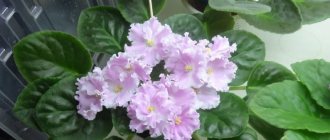Breeders and flower growers fell in love with the African violet so much that in less than 130 years since its discovery, thousands of its varieties have been bred. The plant has changed both the modest blue-violet color of its flowers, as well as their shape and size. The leaves have also changed.
Saintpaulias have become so popular that they are grown in almost every home. There are individual lovers of this flower, whose collections approach a thousand copies. Exhibitions of violets are held regularly, where new varieties are presented. It is simply impossible to talk about everyone at once. Let's get acquainted with individual creations of Russian and foreign selection.
Botanical description of the plant
Ballerina forms a dense rosette of elastic leaves from 20 cm to 40 cm in height. The leaf blade is dark green, oval in shape, with a wavy edge. The young plant blooms about a year after planting. In spring, long flower stalks with numerous buds appear.
Did you know? Violets were the favorite flowers of Josephine Beauharnais, the French empress; she pinned a bouquet of flowers to her dress and decorated her rooms with them.
This variety has virtually no breaks in flowering: as soon as one peduncle fades, the next one appears in new leaves. In this case, the flowers last for about 2 months. The exception is winter, a relative period of rest. Large terry baskets up to 7 cm in diameter are painted white. The petals are arranged in several rows, the middle of the flower is yellow.
A dozen varieties of violets for your window
Pansy, star, bell, bowl, wasp - what do these words have in common? The answer is simple - of course, violet. Her flowers come in this shape. They are also divided according to size, terryness and other external characteristics.
House violet (Saintpaulia ionantha)
photo from almanac.com
If you have not grown violets yet, then you should start with an ordinary indoor Saintpaulia. Outwardly, it is similar to the purple flower that in 1892, during a walk with his bride, was discovered by the military commandant of the Uzambara district of German East Africa, Baron Walter von Saint-Paul. He sent the seeds to his father, who headed the German Dendrological Society. Ulrich von Saint-Paul, in turn, gave them to the botanist Hermann Wendland, who introduced the flower to the world, calling it Saintpaulia in honor of his father and son.
Since then, the Uzambara violet has spread throughout the planet. It is a perennial herbaceous plant with a large rosette and short fleshy stems. Saintpaulia leaves are dark green, heart-shaped, up to 8 cm long, and the flowers are blue-violet.
Apple orchard
photo from extension.unh.edu
Saintpaulias can be of various sizes: from giants (with a rosette diameter of 40-60 cm) to miniature (a rosette up to 6 cm in diameter). Such mini violets include the Yablonevy Sad variety, bred in 2012 by A. Kuznetsov.
Delicate white flowers edged with pink cover a small rosette of dark green leaves. Violet blooms profusely: on each peduncle there are up to a dozen flowers, 2-3 cm in diameter.
Excess fertilizer and sun can lead to flowers turning purple, so shade the plant and do not overdo it with fertilizing.
Vampires Kiss
photo from allaboutafricanviolets.com
A variety for experienced gardeners, because... difficult to grow, and this violet grows very slowly. But the work will pay off handsomely: with each flowering, Saintpaulia becomes more beautiful. It has large dark burgundy semi-double flowers with an almost black border. The leaves are dense, pubescent, dark green in color, and can easily break off.
Flowering lasts a long time, the flowers do not fade for about a month, and lighten over time.
Queen Sabrina
photo from flickr.com
There are violets that combine several varieties. Their subspecies is called the chimera. The petals of such violet flowers have two genetic layers with different colors. Queen Sabrina is also a semi-miniature chimera.
Its large, double, coral-pink flowers have a blue stripe in the center of each petal. The rosette is small (15-17 cm in diameter) with dark green, slightly quilted leaves. Violet always blooms profusely, and with age it becomes even brighter.
It can be negatively affected by the heat, due to which the flowering period is reduced.
Sea Wolf
photo from ebay.com
Giant blue flowers with semi-double corollas, reminiscent of bells, look spectacular against the backdrop of large dark green foliage. This is how the violet variety Sea Wolf, bred by E. Korshunova, appears before us. The flower petals are wavy with a graceful mesh pattern and a white-green edge.
Unlike other violets, it is better to grow a flower of this variety on a well-lit windowsill or loggia.
Blue Dragon
photo from flickr.com
These large double and semi-double light blue violets are recognized not only by the huge size of their corollas, but also by the green border on their wavy petals. Moreover, the border is brighter and wider in cool conditions, but in the heat it is practically absent.
Violets of the Blue Dragon variety are characterized by a powerful rosette (up to 40-50 cm) with dark green leaves, which have jagged edges and a reddish back side. A plant of such impressive size requires increased nutrition and space, so the “dragon” will not tolerate “neighbors” on the windowsill.
Esmeralda
photo from violetbarn.com
The petals of the violet, named after Victor Hugo’s heroine, resemble the wavy hem of a gypsy skirt. This variety is in the collection of two breeders S. Repkina and E. Lebetskaya. The first one has a bright cherry corolla color, the second one is the color of fuchsia or ripe raspberry. The edges of the petals are white.
Large lush flowers look advantageous against the background of evenly colored foliage.
RS Don Juan
The violet bred by S. Repkina bears the name of another literary hero. Large semi-double flowers of purple-plum color are framed by a wide wavy border of golden color. The leaves are large, as is the rosette, which even in young plants reaches 40 cm.
The variety is unpretentious, is not afraid of temperature changes, but loves bright lighting and frequent moderate watering.
EK-White Queen (EK-Belaya Coroleva)
photo from dancinginthegarden.com
Another creation of E. Korshunova, the White Queen violet, also amazes with its huge snow-white corollas. The dark foliage is almost invisible under its double flowers with thin wavy petals.
Grows slowly, prefers cool conditions.
LE-Brilliant Tiffany
Just like the famous diamond, the violet, bred by E. Lebetskaya, shines. Its lush large double white-yellow flowers with wavy green edges glow in the sun like a real jewel. White and pink flowers may bloom on individual peduncles.
The leaves are small, with slightly wavy edges, like the violet itself, and grow slowly. Flowers on it do not wither for a long time and remain fresh.
Conditions for successful growing at home
Violets are, in principle, unpretentious plants; creating the necessary temperature and humidity conditions is not difficult for them.
Placement and lighting
Saintpaulia (the second name for indoor violet) RS-Ballerina - the owner of dark leaves. Such varieties are placed on window sills closer to the glass, on racks - in the first row from the lamp. If the window sills are south, it is advisable to shade them from direct rays of the sun, for example, with white thick paper. In winter, flowers will need to extend daylight hours; the best lighting option would be a fluorescent lamp. Daylight hours should last at least 10 hours.
Did you know? According to Christian myths, violets grew from the tears of Adam, to whom the Archangel Gabriel brought news of the forgiveness of sins.
Temperature and humidity
The most comfortable temperature is +20...+22°C, night temperatures can drop to +19°C. Sudden changes and drafts can lead to disease and death of the flowerpot. The optimal air humidity is 50–60%. In winter, when heating appliances are operating, the air in apartments and houses is dry. To prevent the violet from suffering from this, place a tray with damp expanded clay or moss near the pot. The microclimate around the plant will be what it needs.
Reviews about violet
Marina, Odessa: “The variety loves frequent transplants and responds well to fertilization. But the peduncles are really thin, long and weak. I only keep it for the beautiful shade, which is very rare.”
Zoya, Voronezh: “I often have a desire to get rid of this variety. Peduncles are like strings, always lying on the rosette. The only thing that saves is frequent and abundant flowering.”
How to care at home
Its development and the duration of flowering of the bush depend on the quality care of Saintpaulia.
Important! Spraying the bush is not recommended: the pubescent leaves trap water droplets, increasing the risk of fungal diseases.
Watering
To water the flower, use water that has been standing for at least a day at a temperature of +20°C. Since the bush forms a dense rosette, overhead watering will be inconvenient. In this case, it is better to use watering through a tray. Water is poured in small portions, then left for 10–15 minutes, the remaining water is drained. The frequency of watering will depend on the degree of drying of the top layer of soil 1.5 cm.
Fertilizer application
Long-blooming violets need to constantly replenish their supply of nutrients, so the plants are fed 2 times a month. Balanced mineral complexes are used, for example “Bona Forte for violets and begonias”. According to the instructions, for root feeding you need to dilute 10 ml/1.5 l of water. Experienced flower growers recommend halving the dosage from the manufacturer.
Important! You cannot fertilize a sick plant unless the disease is caused by a lack of nutrition.
Transfer
Every spring, the bush requires soil renewal. The plant is removed from the old container by tapping the edges. Gently shake off the adhering soil; if there are traces of oxidation, it is better to rinse the roots with water and dry them before replanting. Roots that are too long or diseased, damaged roots are trimmed, and the sections are sprinkled with crushed activated carbon.
The surface root system of the plant does not tend to grow much in volume or depth: as the bush grows, old roots die off, and new ones form above the soil surface under the lower leaves, so a new pot is needed no more than 10 cm in volume and the same in height.
To prepare the soil mixture you will need the following components:
- garden soil - 2 parts;
- perlite - 2 parts;
- river sand - 1 part;
- peat - 1 part.
Transplant technology:
- 2-3 cm of drainage (large pebbles, expanded clay) is placed in the pot.
- A bush is placed on a hill of soil with the roots spread out.
- Deepen the bush to the bottom row of leaves and water it.
- If within 2 weeks the plant throws out flower stalks, it is better to cut them off, since the root system has not yet adapted sufficiently.
Find out more about the features of violet transplantation.
My favorite Ballerina - white Uzambara violet and her sisters
There are always a lot of indoor plants in our house. They change periodically. Some die, some get bored. In their place, new wonders are purchased. My love for violets remains unchanged. These sweet homemade, so dear, indoor princesses have won my heart forever. I think that the vast majority of amateur flower growers have paid their attention to them more than once. After all, nature has created many varieties with incredibly beautiful flowers.
Description of the plant
Violets belong to the Gesneriaceae family.
The bushes have a compact, neat appearance. They grow about 20-25 cm. The flowers of these plants are simple and double, with a wavy edge. The flowers are painted in the most incredible colors from delicate shades to rich, very bright colors. Round heads of charming stamens are attached to the flower as a cute decoration: sometimes in tone with the main color of the flower, and sometimes in advantageous contrast. The leaves of violets look like small terry bursts. They are solid green, and in some species they are variegated.
Ads by
Growing conditions
They love violets
- abundance of diffused light
- air humidity 50%
- frequent transplantation
- long daylight hours
They don't like violets
- Sun rays
- it's hot
- drafts
- spraying leaves
- watering with cold water
- sudden temperature change
Planting, transplanting and propagation
I prepare the soil for violets myself: they are very demanding on the structure of the soil.
Very light, breathable, moisture-absorbing, loose soil is suitable for them. I prepare the soil mixture for violets in the following proportions:
- 2 parts garden soil
- 1 part compost humus
- 1/2 part peat
- 1/2 part vermicompost
- 1/4 part vermiculite or perlite
- 3 tbsp. spoon of wood ash per 5 liters of soil mixture
- 1 teaspoon of ZION per 5 liters of soil mixture
I try to replant violets every year, in February, using the transshipment method.
It is necessary to plant violets in such a way that the neck of the plant rises one and a half to two centimeters above the edges of the pot. Violets are propagated using the most popular methods: seeds, leaves or children. 1. Propagation by seeds Prepare a loose substrate, moisten it with a spray bottle, and sow the seeds. Place the container with the crops under the film and place in a warm, bright place. When shoots appear, the film must be removed.
2. Reproduction by leaf Cut a leaf from the plant. Powder the cut area with crushed activated carbon. Let it dry a little. Then place the violet leaf in a glass of clean water. Very soon roots will appear on the leaf. Next, we plant the leaves with roots in the prepared loose soil mixture.
3. Reproduction by children Carefully separate the child from the main bush. We moisten the soil where we will plant the baby abundantly and cover the top with an inverted glass jar or plastic container.
Watering and fertilizing
Watering violets must be approached very responsibly.
You need clean, almost spring water. If you don’t have one, then proceed as follows. Pour tap water into a container. We let it sit for a day so that the chlorine leaves the water. Then we boil the water and cool it to about +30 °C (irrigation water at room temperature is detrimental to the roots of Saintpaulia). Since violets do not like water getting on their leaves, naturally, watering should be done directly into the tray. The tray itself also needs to be washed periodically. I will add that violets need to be watered only when the top layer of soil is completely dry.
I feed violets with complex fertilizer for indoor flowers. Agricola is best suited for this purpose. The frequency of feeding is 2 times a month. It is good to add black tea or coffee grounds to the soil. In winter I don’t feed the plants, I let them rest.
Features of cultivation
For violets, pots must be chosen taking into account the fact that they have a rather small root system.
Therefore, the size of the pots should be low and moderately wide (diameter about 10 cm). The material for the pots is plastic or clay. A layer of expanded clay, pebbles, crushed coal or broken brick must be placed on the bottom of the pot. Since violets love a lot of light, but do not like the sun's rays, it is good to place flower pots on northern and western windows. Moreover, they must be constantly turned towards the light in different directions.
Sometimes, if there are errors in care, violets can get powdery mildew, leaf rust, or bacteriosis. If the first two diseases can be cured fairly quickly with antifungal drugs, then it is useless to fight the latter.
Compliance with all the rules for caring for violets (correct temperature conditions, measured watering, good lighting, balanced feeding, etc.) will help avoid stressful situations for the plant that weaken it.
Don't forget to periodically inspect your violets for insect pests such as aphids, mites, harmful worms and other parasites. Flowers treated with chemicals in a timely manner will delight you and your loved ones for a long time.
There is one more mandatory procedure that I perform weekly. This is pinching off excess shoots and removing the outermost unsightly leaves. I also remove faded, drying flowers. This procedure allows you to increase the decorativeness of the plant.
Interesting Facts
My cat is partial to violets, as probably many other cats are.
The common horror story that violets are very harmful to animals does not have the slightest basis. The flower is recognized as safe for animals. And if you feed your cats vitamins, they will not touch your violets. Violets are the cutest flowers that respond very well to proper care. Admiring and contemplating the beauty around us is what we need now in our difficult times. Another way to ease the self-isolation regime during the coronavirus epidemic.
I can say about myself that I just love them... And they pay me back in kind...
How to propagate at home
The variety is propagated vegetatively: by leaf cuttings or so-called baby. You can purchase planting material in online stores for gardeners.
Cuttings
As a cutting, take a leaf that is elastic and healthy, preferably from the middle row of the rosette.
Sequencing:
- The cuttings are cut at an angle of 40–45°.
- Place it in a container (plastic cup) with water, stirring a charcoal tablet in it.
- Cover the container with a greenhouse.
- After the roots appear, they are transplanted into a pot with soil.
Video: propagation of violets by cuttings
Children
Babies can be grown from a rooted leaf. The approximate period of appearance is 2–6 months.
Technology:
- The young bush is carefully dumped out of the container.
- Separate the baby with its own root system and at least two leaves.
- Transplant into a small pot up to 5–6 cm high.
Video: propagation of violets by children
Methods for propagating Saintpaulia
Cuttings are considered the best way. Beautiful young leaves are selected, and such cuttings can be planted in the soil immediately. They usually produce roots well and quickly.
If you want to root a cutting in water, be careful when planting the rooted leaf in a pot, as the fragile roots often break. The cuttings are planted in a container at an angle of 45 degrees, and the top is covered with glass or a transparent cap and almost “greenhouse” conditions are observed until new young leaves appear.
There are other methods of propagation, less popular, but they help preserve varietal characteristics:
Dividing the bush
Overgrown Saintpaulias often form young rosettes, which can be easily separated from the mother bush with a sharp knife, trying to injure it as little as possible. The young bush is planted in a small pot, watered moderately and grown in a warm room together with the mother plant.
From the peduncle
This method is suitable for hybrid varieties. The most beautiful peduncle is separated from the bush, cut off at the root with a slope of 45 degrees. All buds and flowers are plucked off. This prepared peduncle is incubated in moss (sphagnum) in a small glass and watered with warm water. They cover the top with film, sometimes opening it for ventilation. Young leaves appear after 40 -50 days.
Seeds
The most difficult and time-consuming method. The seeds are sown in a mixture of peat and sphagnum and lightly sprinkled with soil. The container with the seeds is placed in a warm place for a “greenhouse” effect, and after the first leaves appear, they are transplanted into separate pots.
In order for Saintpaulia to please you with long, abundant flowering, you should follow a number of agrotechnical care rules, and the plant will thank you. Although Saintpaulia is considered capricious for home cultivation, you should not be afraid of difficulties, this flower is very responsive to care, and the abundance of varieties will help you find your favorite one and the one that suits you.
And the dancer violet variety always looks beautiful: both in the photo and in natural conditions.
Let's get acquainted with useful tips on how to care for violets when watching the video:
Difficulties in growing
Diseases and pest attacks are easier to prevent with preventive measures. One of them is disinfection of the soil during planting, for example, by calcination or watering with a solution of potassium permanganate. Prevention from pests is to maintain the microclimate of the plant.
You will be interested to know why violet leaves curl and what to do about it, as well as why violets do not bloom at home.
Main difficulties and their elimination:
- Gray rot - the green part of the bush is covered with a fluffy gray coating. Treat the plant by spraying with Topsin-M 1 ml/1 liter of water, repeat the procedure if necessary.
- Root rot - manifests itself in leaf lethargy, yellowing and putrefactive processes. The bush is removed from the pot and inspected. If there is rot on the cuttings, the plant cannot be saved. You can cut a leaf from the top row and root it, but only if the cut is clean. The rescued plant is sprayed with Fitosporin-M 1.5 g/1 liter of water and transplanted into clean, disinfected soil.
- Aphids and thrips. Microscopic sucking insects feed on the sap of the flower, which eventually dries out and dies. Insects are destroyed with the drug “Agravertin”, sprayed with a solution of 2 ml/1 liter of water.
- Shchitovka - a sucking pest with a gray-brown shield on its back. The drug “Aktara” is effective against insects; spray with a solution of 1 g/1.25 l of water.
The snow-white Ballerina will take its rightful place on any windowsill and will decorate any collection of Saintpaulias. Lush and long flowering is one of the main advantages of the variety.











